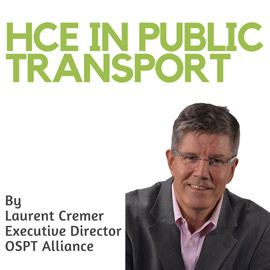HCE in public transport
- Like
- Digg
- Del
- Tumblr
- VKontakte
- Buffer
- Love This
- Odnoklassniki
- Meneame
- Blogger
- Amazon
- Yahoo Mail
- Gmail
- AOL
- Newsvine
- HackerNews
- Evernote
- MySpace
- Mail.ru
- Viadeo
- Line
- Comments
- Yummly
- SMS
- Viber
- Telegram
- Subscribe
- Skype
- Facebook Messenger
- Kakao
- LiveJournal
- Yammer
- Edgar
- Fintel
- Mix
- Instapaper
- Copy Link
Posted: 21 April 2016 | Laurent Cremer, Executive Director, OSPT Alliance | No comments yet
HCE may face usage constraints in public transport but it offers operators considerable benefits. Laurent Cremer, OSPT Alliance’s Executive Director, discusses why HCE in this sector can make mobile transport ticketing the true ‘killer app’ when combined with secure open standards.


HCE may face usage constraints in public transport but it offers operators considerable benefits. Laurent Cremer, OSPT Alliance’s Executive Director, discusses why HCE in this sector can make mobile transport ticketing the true ‘killer app’ when combined with secure open standards.


Host Card Emulation (HCE) is a technology that enables software emulation of a traditional tamper resistant smart card on a mobile phone. To date it is mainly seen as a means of implementing mobile payments without needing to use the secure element (SE). It has been endorsed by the payments associations and a number of banks have launched HCE programs.
Yet it is also of great potential interest to transport operators.
The public transport environment can impose structural constraints that may limit how operators are able to implement HCE. For example, some widely used legacy proprietary ticketing systems cannot support HCE at all.


In addition, today, online HCE cannot meet transport operator throughput requirements where there is a very high volume of passengers entering the transport network. Mobile network coverage can be also an issue. Operators may also have business and security rules that HCE must comply with. Nor do all mobile phones support HCE, especially older handsets.
HCE can offer transport operators multiple benefits
Despite these constraints, HCE can offer transport operators multiple benefits, providing they are willing to embrace open standards.
These include openness, security, investment protection, compatibility with open standards, affordability and the prospect of leveraging what is widely viewed as the most convincing ‘killer app’. HCE facilitates affordable interoperability between closed loop networks and with other application areas such as low value retail payments. Many of HCE’s specific security concerns, such as vulnerability to malware, are already covered by measures put in place by transport operators dealing with proprietary security risks.
Approaches to implementing HCE
There are a number of approaches to implementing HCE – without SE, hybrid, SE in the cloud, with offline support and account based. Each has its advantages and disadvantages for public transport but of these options, some are clearly better suited to the sector.
Indeed, bypassing the SE or implementing certain proprietary, non-standard SEs can make systems very vulnerable and exposed to external malware threats. To avoid this, it is necessary for some kind of SE to be introduced alongside the HCE technology. Mobile devices usually implement the SE in the form of SIM or microSD or embed hardware directly in the device. The alternative approach consists of a pure software solution on the handset, in combination with the use of remote SE, or other forms of risk mitigation measure.
“It is necessary for some kind of SE to be introduced alongside the HCE technology”
If you consider that some forms of standardised SE can be used with HCE, it is no longer as challenging as it used to be to provide mobile ticketing alongside classical contactless smart cards. That’s even the case without making changes to the existing validation infrastructure.
We believe that asynchronous secure transaction systems as used in public transport are currently best supported by secure element technologies such as OSPT Alliance’s open ticketing standard CIPURSE™ or hybrid HCE leveraging CIPURSE.
It’s true that a HCE solution with offline support and without a SE provides significant additional flexibility and reach. Indeed many operators already have the most important components of such a solution in place. However, such a use case should be well supported online through earlier forms of HCE implementation; i.e. registration and sales of transport services are best performed with a NFC phone connecting to its service host. Offline HCE should not be considered as a generic solution for all use cases (e.g. including registration and sales) but in preference a mix of online and offline depending on security requirements. To date, only a highly secure element such as CIPURSE can provide the level of genericity and security to support all use cases.
Looking ahead…
It is this real life combination of HCE, offline credentials, NFC mobile phones and transport network infrastructures built upon open standards that OSPT Alliance is working towards.
Furthermore, implementing CIPURSE adds considerable value to any public transport HCE use case because it facilitates multi-application options, enhances openness and security and protects investment through adherence to standards and multi-platform compatibility.
Related topics
Ticketing & Payments
Related organisations
OSPT Alliance









